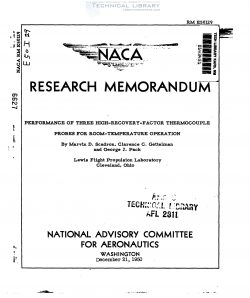naca-rm-e50i29
- Version
- 45 Downloads
- 548.76 KB File Size
- 1 File Count
- April 24, 2017 Create Date
- April 24, 2017 Last Updated
National Advisory Committee for Aeronautics, Research Memorandum - Performance of Three High-Recovery-Factor Thermocouple Probes for Room-Temperature Operation

Thermocouple probes have been designed to measure with-small error
the total temperature of gas moving at high velocities. Two major
designs are presented: one is applicable to the construction of rakes
and the other, of which there are two variations, can be used where
exceptional accuracy is desired. The probes were calibrated. in two Jets;
one Jet exhausted. into the atmosphere and the other into a pressure-
controlled receiver.
These probes were capable of measuring 99. 6 percent or more of the
stagnation temperature 'at a free-stream Mach umber of 1.0 and stagna-
tion temperature or about 540° R. The probes were insensitive to mis-
alinement to flow in the yaw angle up to 11:50". The error in measuring
stagnation tam emserature was increased by about 0.1 percent for Mach
numbers above 3 as the air density was reduced. from 0.10 to 0.04
pound. per cubic foot. The variation in recovery factor for four
probes of a given desim was very small at a given Mach number.
When a temperature-sensing probe is inserted in a high-velocity
gas stream, the temperature indicated is the summation of static or
free-stream temperature and sane portion of the theoretical temperature
rise corresponding to the directed kinetic energy of the gas stream.
The ratio of the actual temperature rise of the thermocouple above the
free-stream temperature to the temperature rise that would be caused by
canplete adiabatic stagnation is termed "recovery factor." The ratio
between. the actual temperature indication and. the true stametion tem-
perature represents the accuracy of indication oi‘ stagnation tempera-
ture by the themocmple.
The accuracy of temperature indication is a function not only of
recovery factor but also of the rate of heat flow by conduction and
radiation from the thermocouple Junction to the surroundings. The
design requirements for'high recovery and for low heat transfer are
generally contradictory. A thermocouple located in a blind-end tube
with the open and facing upstream would thus insure complete stagnation
of the air surrounding the thermocouple. The response to a change in
outside air temperature would be extremely sluggish, however, and the
rate of heat loss by conduction along the thermocouple wires and sup-
ports would be large relative to the rate of heat conduction fran the
gas to the thermocouple.
| File | Action |
|---|---|
| naca-rm-e50i29 Performance of Three High-Recovery-Factor Thermocouple Probes for Room-Temperature Operation.pdf | Download |

Comment On This Post